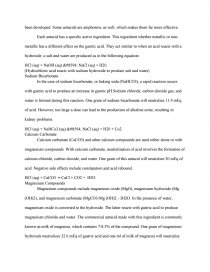Antacids- Classification and Mechanism of Action
Essay by review • February 17, 2011 • Research Paper • 1,396 Words (6 Pages) • 5,635 Views
Essay Preview: Antacids- Classification and Mechanism of Action
ANTACIDS- Classification and Mechanism of Action
INTRODUCTION
Antacids are defined as a substance, generally a base, which counteracts stomach acidity. The name antacid means anti-acid (against acid). Antacids are the primary treatment for ailments such as gastric reflux, gastritis, upset stomach and heartburn. Hydrochloric acid is secreted by the stomach to kill harmful organisms, aid digestion and activate digestive enzymes. Excess secretion of acid into stomach or impaired resistance by the lining of the stomach or reflux into the oesophagus may produce symptoms and the treatment of these symptoms is by reducing the acidity in the stomach.
CLASSIFICATION OF ANTACIDS
Antacids can be classified into two main classes based on the mechanism used to counteract the stomach's acidity. One class works by chemical neutralisation of gastric acid (absorbable antacids) and the other class acts by absorption of the acid (non-absorbable antacids). Antacids are sometimes even formulated with additional components such as dimethicone and alginic acid. They are not to be confused with gastric acid inhibitors such as cimetidine and ranitidine.
Absorbable Antacids
The absorbable antacids (chemical antacids) show the most rapid onset of action and provide faster relief of symptoms. However they may cause an "acid rebound", a condition whereby the gastric acid returns in greater concentration after the drug effect has ceased. Moreover, this class of antacids is not suitable for all patients owing to its components. For example, the usually high concentration of sodium bicarbonate present in these chemical antacids may be inappropriate for patients afflicted with hypertension or kidney failure.
Non Absorbable Antacids
The non-absorbable antacids though less prone to cause a rebound effect, have their fair share of pros and cons. The most obvious disadvantage would be that these antacids interfere with the absorption and action of other drugs. Moreover as these antacids are more potent and effective in a semi liquid or liquid form than in a capsule or table, it may be inconvenient for routine dosage. However, non-absorbable antacids have numerous advantages. They have additional uses beyond hyperacidity. Calcium salts may be used as diet supplements to prevent osteoporosis. Aluminum carbonate is used for binding phosphate, and has been effective in control and treatment of hyperphosphatemia (too much phosphate in the blood); it also can be used with a low phosphate diet to prevent formation of phosphate urinary stones. The usually high presence of aluminum and magnesium hydroxides in non-absorbable antacids can be effectively used to prevent significant stress ulcer bleeding in post-operative patients or those with severe burns.
MECHANISM OF ACTION OF ANTACIDS
Antacids were developed based on the hydroxides and carbonates of the group II and III metals, as well as the bicarbonates of the alkali metals. All antacids contain at least one of the following metals: aluminum, calcium, magnesium, sodium, potassium, or bismuth. Antacids help neutralize excess acid produced in the stomach, i.e. the hydrogen ion concentration is reduced. The effectiveness of antacids is determined by its rate of reaction and residence time, which in turn are affected by various factors. Since metal-containing antacids can interfere with the absorption of many prescribed medications, especially antibiotics, non-metal antacids also have been developed. Some antacids are amphoteric as well, which makes them far more effective.
Each antacid has a specific active ingredient. This ingredient whether metallic or non-metallic has a different effect on the gastric acid. They act similar to when an acid reacts with a hydroxide; a salt and water are produced as in the following equation:
HCl (aq) + NaOH (aq) → NaCl (aq) + H20.
(Hydrochloric acid reacts with sodium hydroxide to produce salt and water)
Sodium Bicarbonate
In the case of sodium bicarbonate, or baking soda (NaHCO3), a rapid reaction occurs with gastric acid to produce an increase in gastric pH.Sodium chloride, carbon dioxide gas, and water is formed during this reaction. One gram of sodium bicarbonate will neutralize 11.9 mEq of acid. However, too large a dose can lead to the production of alkaline urine, resulting in kidney problems.
HCl (aq) + NaHCo3 (aq) → NaCl (aq) + H20 + Co2.
Calcium Carbonate
Calcium carbonate (CaCO3) and other calcium compounds are used either alone or with magnesium compounds. With calcium carbonate, neutralization of acid involves the formation of calcium chloride, carbon dioxide, and water. One gram of this antacid will neutralize 20 mEq of acid. Negative side effects include constipation and acid rebound.
HCl (aq) + CaCO3 = CaCl + CO2 + H2O
Magnesium Compounds
Magnesium compounds include magnesium oxide (MgO), magnesium hydroxide (Mg (OH)2), and magnesium carbonate (MgCO3-Mg (OH)2 - 3H2O. In the presence of water, magnesium oxide is converted to the hydroxide. The latter reacts with gastric acid to produce magnesium chloride and water. The commercial antacid made with this ingredient is commonly known as milk of magnesia, which contains 7-8.5% of the compound. One gram of magnesium hydroxide neutralizes 32.6 mEq of gastric acid and one ml of milk of magnesia will neutralize approximately 2.7 mEq of acid. Magnesium compounds have the advantage of producing little absorption, having a prolonged action, and generating no carbon dioxide (except for magnesium carbonate). However, the magnesium chloride that is produced acts as a laxative; therefore, most commercial formulations also contain calcium carbonate or aluminum hydroxide to prevent this problem.
MgO + H2O = Mg (OH)2
HCl (aq) Mg (OH)2 = MgCl2 + H2O
Aluminum Compounds
Aluminum compounds include aluminum hydroxide (Al (OH) 3), aluminum carbonate (Al2O3 - CO2),
...
...





